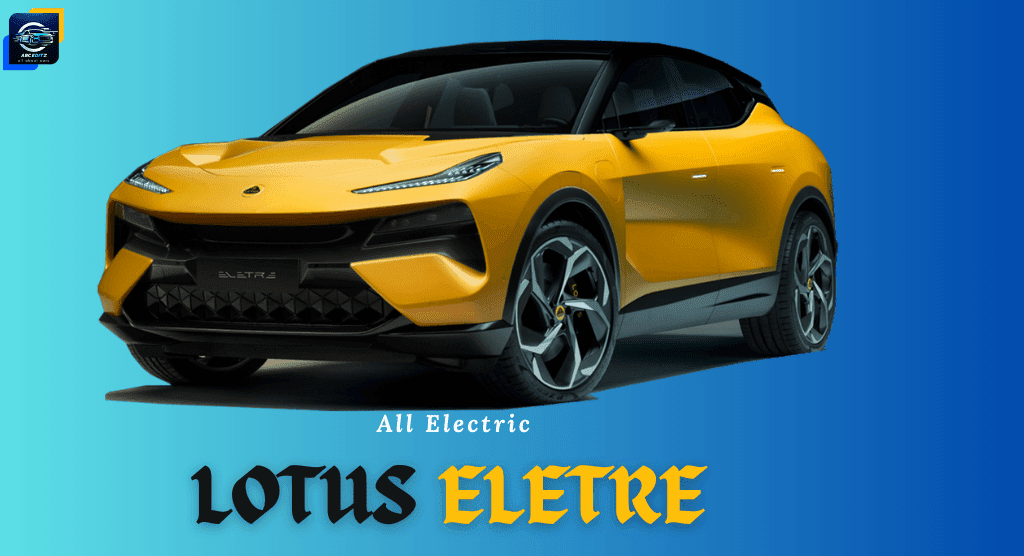The SUV is designed to achieve a maximum range of 600 kilometers on a single charge and can recharge its battery in just 18 minutes using a 350kW charger.
Lotus has unveiled its inaugural all-electric SUV, the Eletre, marking the brand’s entry into the high-performance luxury crossover segment. This launch also signifies Lotus’ transformation into an electric-only performance car brand, expanding its offerings beyond the sports cars for which it is renowned. The Eletre is the first among four new electric vehicles scheduled to debut from the British automaker by 2025.
Drawing inspiration from the Lotus Emira and Lotus Evija, the Eletre features a 600 horsepower powertrain, offering a maximum range of 600 kilometers. Manufacturing will take place in Wuhan, China. The Eletre, meaning ‘coming to life’ in Hungarian, will be available in three variants, each with distinct performance and specification attributes, while four-wheel drive will be standard across all models.

Electric Lotus Eletre Design
The Eletre’s design originated from the Lotus Technology Creative Centre (LTCC) in Coventry, England, which serves as the brand’s new design hub for its ‘lifestyle cars.’ Despite the shift, the design of its sports cars will continue to be crafted at Lotus’ headquarters in Hethel, UK. The aesthetic appeal of the Eletre draws inspiration from the Lotus Evija and Emira, featuring a cab-forward stance, a lengthy wheelbase, and minimal front and rear overhangs. The compact bonnet pays homage to Lotus’ historic mid-engined layout.
Ben Payne, head of LTCC and lead designer for the Eletre, emphasized the effort to create a forward-focused design with a short hood and a sharp nose, contributing to the illusion of length, lower profile, and sleekness. Several design elements, such as sharp edges at the front, resemble those found in the Lotus Evija and Emira. The glass canopy atop the body echoes the style of the Evija.
A key aerodynamic aspect of the design is its ‘porosity,’ optimizing air flow through, under, over, and around the car to reduce resistance, enhance efficiency, and improve range, speed, and performance. Air channels under the leading edge, emerging through vents on the bonnet, can be observed, as well as behind the front and rear wheel arches and atop the D-pillar.
At the rear, the SUV features a full-length ribbon light curving into air outlets from the wheel arches, a design shared with the Emira and Evija. The color of the light changes based on the car’s movement and battery charge.
The rear incorporates a carbon fiber, three-stage deployable split roof-mounted spoiler, inspired by race car winglets. Weight-saving measures include omitting the central part of the spoiler to reduce weight. Additionally, the charging port is strategically placed on the front wing to minimize internal cabling and excess weight.
Notably, the door handle lines will not be retained in the road-ready version, and Lotus will offer 22-inch wheels in addition to the 23-inch ones depicted in the images.
2023 Lotus Eletre: interior and technology
The interior of the Eletre is notably infused with advanced technology. A key feature is the 15.1-inch landscape-oriented touchscreen infotainment system that folds flat when not in use, aiming to set new standards in the automotive world, according to Lotus. The dashboard, resembling the design of the split spoiler at the rear, is divided into two sections. Below, a light blade spans the entire width of the dashboard, capable of changing colors to communicate with occupants, such as flashing for an incoming phone call. Beneath this is the ‘ribbon of technology,’ comprising three distinct screens. Instead of a traditional instrument cluster, there are 30mm strips on either side of the dashboard displaying crucial vehicle information, with the third screen being the aforementioned infotainment display.
While digital and voice commands control most functions, certain key features like heating have analogue dials. A dashboard camera senses the driver’s gaze, adjusting screen brightness accordingly, minimizing distraction. The SUV incorporates a dedicated smartphone app, 5G data compatibility, and over-the-air software updates. Inspired by the Emira and Evija, the driver-centric cockpit and elevated center console aim for a visually lightweight design.
Lotus employs sustainable materials such as Kvadrat on select touchpoints and a wool-blend fabric on the seats, weighing 50 percent less than traditional leather. The SUV features a five-seat bench layout with a split-folding rear bench, except for the Chinese market, where a four-seat layout will be available.
Electric Lotus Eletre: under the skin
The Eletre employs an entirely new platform developed by Lotus known as the Electric Premium Architecture (EPA). This skateboard-style design is highly adaptable, accommodating various car sizes, battery sizes, electric motors, component layouts, and intelligent driving technologies.
While specific technical details are yet to be disclosed, Lotus has set ambitious performance targets, aiming for a top speed of 260 km/h and a sub-3.0-second acceleration time for the 0-100 km/h sprint. Each Eletre model will feature a battery capacity exceeding 100 kWh, delivering over 600 horsepower. The SUV is designed for a maximum range of 600 km, with a rapid 18-minute recharge capability from a 350 kW charger.
Standard features include air suspension, active aerodynamics, and active ride height. Optional upgrades encompass active dampers, active rear-axle steering, and torque vectoring facilitated by an electronic limited-slip differential. Lotus emphasizes that every Eletre will offer exceptional dynamics, outstanding comfort, and genuine Lotus performance.
Manufacturing of the Eletre will take place at Lotus’ new facility in Wuhan, China.
Check out – Hyundai Creta EV
